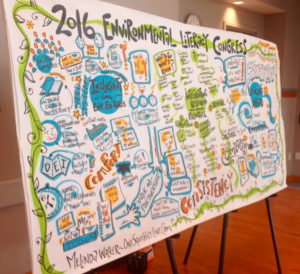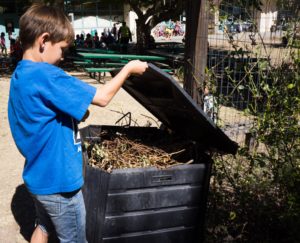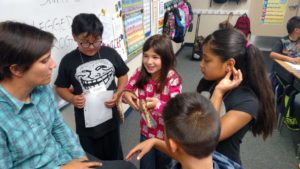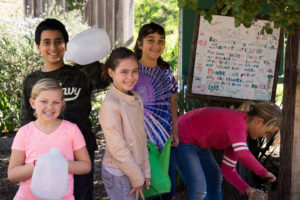
Last week I attended ChangeScale’s 2nd Annual Environmental Literacy Congress. Beyond just learning from the presentations, I had a true ‘aha’ moment when I looked around at all the different organizations being represented and realized that environmental literacy is not a sidelined goal or initiative. We are at the beginning of a growing movement that is starting to hit its stride. So, why the hashtag in my title? To hopefully spur more organizations to spread the word about the great work they are doing in this field through social media and a shared hashtag—#EnviroLiteracy.
During the Congress our different tables were asked to read new research bulletins that ChangeScale has released in partnership with Dr. Nicole Ardoin of Stanford University. Our table read about how environmental literacy develops a sense of place for students, which sparked a conversation about how important it is to define ‘the environment’ for students through local context.
 We unanimously agreed that there is a perception that when you are talking about ‘the environment’ people tend to think of environmental landmarks such as mountains, valleys, rivers, lakes, and beaches. However, students across California live in all different kinds of environments, and an environment can be found anywhere you look—whether it is your local park or a crack in your school’s playground. Research indicates that students relate to the environment when they are doing an activity in nature as opposed to relating to its aesthetic beauty. Our group discussed how students don’t necessarily need to climb a mountain and see the pretty view to connect to the environment. Teachers can connect their students to the environment around their schools and in their communities.
We unanimously agreed that there is a perception that when you are talking about ‘the environment’ people tend to think of environmental landmarks such as mountains, valleys, rivers, lakes, and beaches. However, students across California live in all different kinds of environments, and an environment can be found anywhere you look—whether it is your local park or a crack in your school’s playground. Research indicates that students relate to the environment when they are doing an activity in nature as opposed to relating to its aesthetic beauty. Our group discussed how students don’t necessarily need to climb a mountain and see the pretty view to connect to the environment. Teachers can connect their students to the environment around their schools and in their communities.
 Ten Strands learned how powerful connecting students to their own environment is through stories shared with us by teachers and educators that we work with. I shared with my table one of these stories, which is also featured on our blog. Julie DiMaio is a teacher who participated in our summer learning collaborative, where she developed an environment-based NGSS science unit and taught it in her classroom this past fall. Her school is located across the street from San Francisco International Airport— the school is surrounded by a chain link fence and was built on asphalt. This did not stop Ms. DiMaio from finding a way to connect her students with their environment via studying their local frogs. She was able to get the airport biologist to come into their classroom and teach her students about the endangered California red-legged frog and endangered San Francisco Garter Snake. Learning about their neighboring species inspired the students to help protect these vulnerable animals, and spurred them to make presentations to the school about how students could do their part to so that the animals have a healthy environment to live in. Julie wrote that her students were “self-motivated and engaged. They had a sense of purpose: the unit was both relevant and authentic. Not a single one asked what their grade was. It didn’t matter: They knew they made a difference and they felt honored.” #EnviroLiteracy in action!
Ten Strands learned how powerful connecting students to their own environment is through stories shared with us by teachers and educators that we work with. I shared with my table one of these stories, which is also featured on our blog. Julie DiMaio is a teacher who participated in our summer learning collaborative, where she developed an environment-based NGSS science unit and taught it in her classroom this past fall. Her school is located across the street from San Francisco International Airport— the school is surrounded by a chain link fence and was built on asphalt. This did not stop Ms. DiMaio from finding a way to connect her students with their environment via studying their local frogs. She was able to get the airport biologist to come into their classroom and teach her students about the endangered California red-legged frog and endangered San Francisco Garter Snake. Learning about their neighboring species inspired the students to help protect these vulnerable animals, and spurred them to make presentations to the school about how students could do their part to so that the animals have a healthy environment to live in. Julie wrote that her students were “self-motivated and engaged. They had a sense of purpose: the unit was both relevant and authentic. Not a single one asked what their grade was. It didn’t matter: They knew they made a difference and they felt honored.” #EnviroLiteracy in action!
The most exciting part to me goes beyond Julie’s story. We featured another blog post from Juanita Chan, Science Lead at the Rialto Unified School District, about teachers using their local environment to teach science. Rialto is a completely different environment than where Julie’s kids are. It is a chaparral—no beach, no mountains, and no desert. Ms. Chan asks, “How can you be a tree hugger in a community where there are no trees?” Teachers in her district started by teaching their students about local endangered species, how Rialto gets water, and how to optimize land use. Through this learning students were inspired to work on public service announcements to inform the community about native plants and animal species, create a water conservation calendar, design plans to xeroscape the campus, and design a space to grow fresh vegetables for seniors in need.
 It is incredible to me that two different teachers in two completely different places in California were able to teach their students standards-based lessons that connected to their local environment ultimately leading to students taking action to better their community. To me, this is the true power of #EnviroLiteracy. When I start to imagine what these students will go on to do for their communities, California, our country, and the world, it makes me hopeful for a future healthy planet.
It is incredible to me that two different teachers in two completely different places in California were able to teach their students standards-based lessons that connected to their local environment ultimately leading to students taking action to better their community. To me, this is the true power of #EnviroLiteracy. When I start to imagine what these students will go on to do for their communities, California, our country, and the world, it makes me hopeful for a future healthy planet.
Check out what students are already doing around the world to protect their environment:
- U.S. Magistrate Judge Thomas Coffin of the federal District Court in Eugene, OR decided in favor of 21 young plaintiffs and Dr. James Hansen on behalf of future generations in their landmark constitutional climate change case brought against the federal government and the fossil fuel industry:
- United Nations Youth Portal offers a broad range of information on climate change initiatives, projects, campaigns, educational tools, websites, and publications produced by and for young people:
- Baltimore 20-year-old stopped an incinerator and became an international hero:
- Last year’s Brower Youth Award winners:

